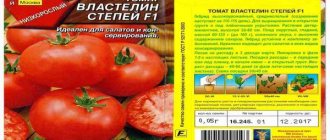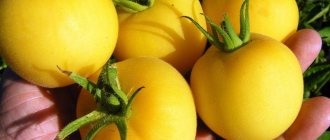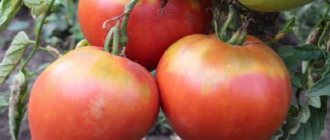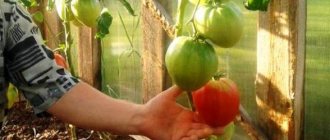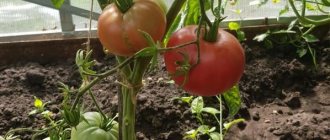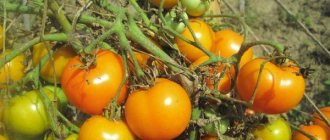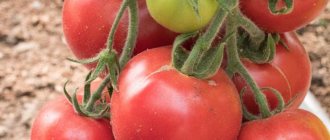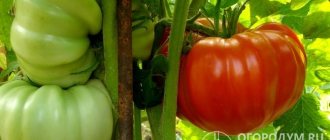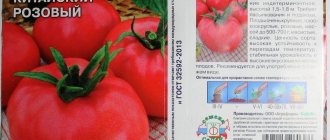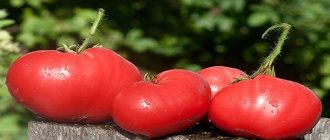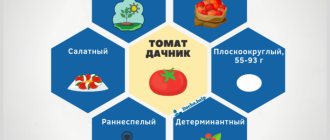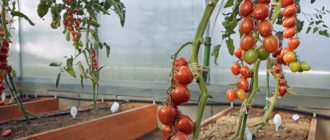Good tomato varieties don't just happen. This is the result of the fruitful activity of breeders. Pink raisins are a productive cultivar of Ukrainian selection with excellent taste and high marketability.
| Height | Landing location | Ripening time | Fruit color | Fruit size | Origin | Fruit shape |
| Medium height | Greenhouse, Open ground | Early ripening | Pink | Average | Variety | Plum-shaped or oval |
Description of the hybrid
Pink raisins are a first generation tomato hybrid. This is indicated by the mark f1. It was bred by crossing two parent varieties, so you cannot use seeds from independently grown fruits. They will grow into tomatoes with parental characteristics.
The hybrid was bred by Ukrainian breeders. It is not included in the Russian state register. Despite this, Pink raisins are popular and have positive reviews from gardeners in our country.
Distinctive features of Pink raisins
Pink raisins stand out among other tomatoes for their fruits, which combine the qualities of the most popular tomato varieties. The berries of this hybrid are pink in color and miniature in size. Their shape is elongated, so they resemble cream.
Tomatoes have a rich, sweet taste with a pronounced tomato aroma. The pulp is dense but juicy.
Another characteristic feature of the hybrid is the ability to set a large number of fruits. Up to 50 berries are formed on one brush.
Characteristic
The description of Pink raisins will surprise even experienced gardeners. It is distinguished not only by early ripeness, high yield and excellent taste of fruits, but also by ease of care.
Characteristics of Pink Raisin:
| Parameter | Indicators |
| Bush type | Determinate, ends its growth with a flower brush. Does not apply to standard ones. The bush grows up to 1.3-1.5 m. The stems of the hybrid are strong, erect, and thick. Covered with medium amount of foliage. The bushes are spreading. The leaves are medium-sized, light green, wrinkled, without pubescence, typically tomato-like. Has complex intermediate inflorescences. The first inflorescence is formed in the axil of 6-8 leaves, the next ones - every 1 leaf. The fruits are produced in complex fan clusters. Each brush contains up to 50 berries. The peduncle has an articulation. |
| Growing method | Tomato is resistant to negative environmental factors. Suitable for growing in greenhouses and open ground. |
| Productivity | High. 6 kg of berries are harvested from 1 plant. From 1 sq. m manages to get up to 15 kg of tomatoes. |
| Fruit | Small cocktail tomatoes. The weight of one berry varies between 30-60 g. The length of the fruit reaches only 5-6 cm. The color is pink inside and outside. The skin is shiny, with a slight pearlescent appearance. There may be lighter and darker stains on the skin and light spots inside. The shape is elongated, smooth. The pulp is juicy and tender. The taste is sweet with barely noticeable sourness. Dry matter content – 5%. Each berry has 2-3 seed chambers. |
| Transportability | High. Pink raisins have a strong skin that protects the berries from cracking and other damage during transportation. Fruits can be stored for more than a month at room temperature. |
| Ripening time | Early ripening hybrid. The first harvest can be harvested 3 months after sowing the seeds. Fruiting continues until autumn. |
| Disease resistance | It is resistant to the most common diseases of nightshade crops and rarely suffers from late blight. |
Note! In the Pink Raisin tomato, more fruits are formed on the lower clusters. The higher the brush, the fewer berries it contains.
Description of tomato Raisin, characteristics and types with reviews
The Raisin tomato belongs to the first generation hybrids and is intended for cultivation in film greenhouses. Friendly ripening of fruits, abundant fruiting and high taste are the main characteristics of the variety.
Advantages of a hybrid
Tomato Raisin f1 is an early-ripening hybrid and is intended for cultivation in closed ground conditions. The period of fruit ripening from emergence is 90-100 days. The plant is of medium height, the height of the bush reaches 1 m.
4-5 clusters are formed on the main stem. Each of them contains 15-20 pink fruits, shaped like a plum. The crop yield is 2.5-3 kg per 1 m². The value of the hybrid lies in the simultaneous ripening of the fruits.
Tomatoes are distinguished by their high taste, presentation, and ability to be transported over distances. In cooking, the fruits are used for canning and are consumed fresh.
Tomatoes have delicacy and design advantages. They are used whole or cut to decorate dishes, desserts, and cocktails. Cherries complement the taste of hot chicken and fish skewers.
Varieties of tomatoes
Cherry tomatoes, as seen in the photo, are distinguished by small fruits, similar to cherries, slightly elongated in shape. Cherry tomato contains a large amount of dry nutrients and sugars dissolved in intercellular juice.
Selection work has led to the appearance of fruits with different flavors and colors. The hybrid is distinguished by its decorative appearance during flowering and during the ripening period.
Tomato Raisin During the growing season, a bush 1 m high is formed on the main stem; 4-5 clusters with pink fruits weighing 20-30 g are formed.
The Pink Raisin tomato is a mid-early variety with unlimited growth. The leaf is medium in size, light green in color, and has a wrinkled structure. A complex inflorescence is formed at the level of 6-8 leaves and is then laid at intervals of 1 leaf.
A high yield is achieved when the plant is formed into 2-3 stems. The tomatoes are elongated, resemble a plum in appearance, and at the ripe stage, as can be seen in the photo, are rich pink in color with a pearlescent tint.
Description of fruits:
- Up to 50 fruits ripen on 1 cluster, about 5 cm in size.
- The weight of a tomato reaches 50-150 g.
- When cut horizontally, 2-3 chambers with seeds are visible.
- The skin is smooth, thin, the flesh is fleshy, dense, sweet in taste.
- Ripe tomatoes can hang on the trusses for a long time without losing their appearance.
The tomato has a high degree of disease resistance and is intended for cultivation in open ground and greenhouses.
Agrotechnics of cultivation
The characteristics and description of the variety indicate the ease of caring for the crop during the growing season. The agricultural technology for growing Cherry is no different from ordinary tomatoes.
Since most varieties are of hybrid origin, they are characterized by high seed germination, resistance to external conditions, and abundant fruiting. To achieve a good result, it is important to pay attention to regular watering of the crop and timely fertilizing with complex fertilizers.
To speed up the ripening of fruits and maintain the balance of moisture and air near the root system, it is recommended to mulch the soil using black fiber. Its use will ensure uniform nutrition of moisture to the root system.
All types of Cherry tomatoes require garter, regardless of the height of the stem. For low-growing varieties, it is recommended to maintain a distance between bushes.
Growing seedlings
Pink raisin seeds are sown for seedlings 55 days before planting the plants in open ground. The beginning of growing seedlings depends on the climatic conditions of the region:
- southern regions - late February or early March;
- northern regions – early April;
- zone with a temperate climate - the second half of March.
If you plan to plant tomatoes in a greenhouse, sowing seeds begins 2 weeks earlier.
Processing of planting material
Pink raisin seeds are sorted. Darkened and damaged specimens are discarded. It is important to ensure that the seeds are not covered with mold.
Manufacturers often produce seeds that have been treated in a factory. Information about this is indicated on the packaging. Treated planting material is identified by its orange or light green color.
If the seeds are not disinfected by the manufacturer, they are processed at home by soaking:
- for 30 min. in a weak solution of potassium permanganate;
- for 15 min. in hydrogen peroxide;
- for 12 hours in aloe juice.
Advice! Aloe juice, diluted half and half with water, not only disinfects the seeds, but also accelerates their germination. The most effective are products made from leaves older than 3 years.
After disinfection, the seeds are treated with a growth stimulator. This not only accelerates their germination, but also increases the immunity, cold resistance and endurance of plants.
To stimulate growth, purchased and homemade products are used. The list contains the most popular of them:
- "Epin";
- sodium humate;
- water with honey;
- aloe juice
Selection of containers and soil
For sowing seeds, choose large, shallow containers. Gardeners often use improvised materials for these purposes, for example, plastic dishes and packages of semi-finished products.
Plastic and peat pots, disposable cups and cut-off bottles are used as individual containers for seedlings.
Advice. A 5-liter bucket of small berries is collected from one Pink raisin bush. Most gardeners plant only 2-3 bushes of this hybrid. In this case, it is better to sow the seeds in individual peat tablets.
Containers for sowing seeds are disinfected by soaking for half an hour in a strong solution of potassium permanganate. Sterilizing pots with boiling water is no less effective.
Many gardeners prefer to make their own soil for tomatoes. To do this, take soil from the beds where adult tomatoes will grow. It is mixed in equal proportions with peat and humus. If the acidity of the soil is increased, add ash. Take a glass of ash for one bucket of soil mixture.
The soil mixture is also sold in specialized stores. It contains all the necessary microelements.
The soil for growing seedlings is disinfected in one of the following ways:
- pouring boiling water;
- watering with a dark pink solution of potassium permanganate;
- calcination in the oven or microwave.
Sowing seeds
The boxes are filled with soil mixture, which is abundantly moistened with warm water. Grooves 1 cm deep are made in the soil at a distance of 3 cm. Seeds are placed in them at intervals of 1.5-2 cm. The planting material is sprinkled with a layer of earth without compacting.
The containers with seeds are covered with film and put in a warm place. It doesn't have to be well lit. Seeds do not need sunlight before germination.
When sowing in peat tablets, they are pre-soaked in boiling water, placing them in a container with the holes facing down. When the workpieces swell, they are removed from the container. The planting material is buried in the peat using a toothpick. All tablets are placed in one container, which is covered with film and put in a warm place.
Seedling care
Growing seedlings yourself is not difficult if you follow the basic rules for caring for them:
- When the first shoots appear, the film is removed. Plants are moved to a well-lit place. If natural light is not enough, use a fluorescent lamp.
- Experienced gardeners advise, after seed germination, to remove tomatoes for a week in a cool place with a temperature of 16-17 ºC. Then the seedlings are placed in heat again. This prevents plants from stretching out prematurely.
- The soil is moistened as it dries (on average 3 times a week). Use only settled water at room temperature. The liquid should not fall on the above-ground part of the plants.
- It is important that the seedlings do not stand in a draft. Otherwise, fragile plants will simply die.
- If the seeds are sown in a common container, after the first true leaves appear, the seedlings are planted in individual pots. Drainage must be placed at the bottom of tomato containers.
- After transplanting, the seedlings are not fed or watered for 10 days.
- Tomatoes are fed 3 times during the period of growing seedlings. Use organic and complex fertilizers with phosphorus.
- 2 weeks before planting in a permanent place, the seedlings are hardened off by taking them out into the fresh air. Hardening begins at half an hour, gradually increasing the time.
Photos, videos, reviews, description, characteristics, productivity of the plum-shaped tomato variety “Pink Raisins”
The Ukrainian variety “Pink Raisins” is still not included in the State Register of the Russian Federation, however, it enjoys well-deserved popularity throughout Russia. The peculiarity of this tomato is its huge fruit clusters, including up to 50 tomatoes, which is why they look like grapes.
"Pink raisins" are classified as an early tomato. The fruits ripen 90-100 days after emergence. The bush is determinate; in a greenhouse it grows up to 1.5 meters. The stamp is missing.
Other characteristic features of the plant:
- Complex inflorescence of intermediate type. Includes up to 50 flowers. Lay over 6-8 sheets, then at intervals of 1 sheet;
- Most of the fruits are formed on the lower racemes;
- The foliage is medium, “potato” type leaf;
- Developed root system, occupying at least 50 cm in diameter.
Fruit
Tomatoes have an oblong plum-shaped shape. The size of the fruit is small: weight ranges from 50-150 grams, diameter – no more than 5 cm. During the ripening process, the skin changes color from pale green to pale pink.
Other fruit characteristics:
- Small-chambered (2-3 seed compartments);
- Average dry matter content (5%);
- Juicy and sweet pulp.
“Pink raisins” have the following benefits:
- High yield;
- Early maturation;
- Various applications;
- Formation of ovaries in any weather;
- Keeping quality;
- Great taste;
- Lack of tendency to cracking of fruits.
Among the disadvantages of the variety, the need for gartering and pinching should be noted.
Application of fruits
Due to its excellent tolerance to heat treatment and preservation of commercial qualities for a long time, “Pink Raisins” are ideal for preservation in their entirety. In addition, tomatoes can be consumed fresh, processed into juice or pickled in barrels.
Growing tomatoes
“Pink Raisin” is a universally grown tomato. It is equally successfully cultivated in greenhouses and open ground.
How to prepare seeds?
IMPORTANT : When working with seed material, it is necessary to maintain sterile conditions: disinfect containers and equipment, handle with disposable gloves.
Pre-sowing preparation involves activities:
- Disinfection in hydrogen peroxide or potassium permanganate (for 15 minutes). Destroys surface bacteria;
- Soaking in solutions of stimulants (Epin, Kornevin). Necessary to strengthen the immune system;
- Hardening on the top shelf of the refrigerator for 48 hours. Increases plant resistance to weather changes;
Sowing seed material
Sowing is carried out 2 months before planting for permanent residence. The substrate for seedlings is bought in the store, or a mixture of turf, peat and sand is used in a ratio of 2:2:1. Seeds are sown in furrows to a depth of 1-2 cm.
Shoots appear approximately 5-7 days after sowing. Until this time, seedlings should be grown under a transparent cover at a temperature of 28-30*C. After the sprouts have pecked, the cover is removed and cultivation continues at 22-24*C.
Seedlings need constant watering and complex fertilizing 2 times a month. Picking is carried out after the appearance of the 2nd true leaf.
Rules for planting seedlings
Seedlings are transplanted for permanent residence when the soil warms up to 14-16*C. In middle latitudes, this period corresponds to the end of May - beginning of June, in the south - 2-3 weeks earlier. Plants by this time grow to 30-35 cm and acquire 6-7 true leaves.
IMPORTANT : The soil temperature must be measured at a depth of 10-15 cm.
Recommended planting pattern:
- The depth of the planting hole is 12-15 cm;
- The distance between plants is 70 cm;
- Row spacing – 70 cm;
- Maximum density – 2 bushes per 1 sq.m.
Bush care
Plants need moderate pinching of 2-3 stems. Side shoots and lower leaves are removed when they reach a length of 4-5 cm. Due to the large mass of fruit clusters, the bushes require garters to posts or trellises.
Other agricultural practices do not differ from generally accepted ones:
- Regular watering to a depth of 25-30 cm;
- Mulching the soil with crushed straw (layer up to 20 cm);
- Removing weeds (especially in the first week after planting);
- Feed once every 2-3 weeks.
Diseases and pests
The originator does not provide data regarding the incidence of the variety. To prevent diseases, it is recommended to periodically spray the plants with garlic infusion and Fitosporin.
Productivity
If the recommended planting density is observed, up to 6 kg of crop is harvested from 1 plant.
Which regions are best to grow in?
“Pink raisins” are intended for cultivation throughout the Russian Federation. In the southern regions, the variety is cultivated in open ground, in other areas - in greenhouses and greenhouses.
Reviews about the variety from those who planted
The variety is valued for its productivity and excellent taste. The plant blooms consistently in any weather. “Pink raisins” are grown mainly for fresh food.
Pink varieties of tomatoes:
We recommend articles on the topic
0
Source: https://web-selo.ru/slivovidnyj-sort-tomata-rozovyj-izyum-foto-video-otzyvy-opisanie-harakteristika-urozhajnost.html
Agricultural technology of Pink raisins
Seedlings are planted in the ground when the soil warms up. For early-ripening tomatoes, it is especially important to adhere to the timing of picking. If you keep seedlings in pots, it will be more difficult for them to adapt after picking.
The time for planting the Pink Raisin tomato depends on the climatic conditions of the region. The further north the city is, the later the seedlings are planted in open ground.
Planting tomatoes in a permanent place
When choosing a site for growing tomatoes, it is important to consider several nuances:
- Tomatoes are light-loving plants. For them, choose a plot of the garden that is in the open sun.
- Tomatoes should not be planted in beds where nightshade crops have grown for the past 3 years. The best precursors for tomatoes are legumes, melons, onions, and cucumbers.
- It is important to choose the right neighbors for tomatoes. Potatoes should not be planted near the tomato beds. If tomatoes are grown in a greenhouse, no other plants are planted in the same room.
It is important to properly prepare tomato beds. They are dug up and cleared of plant debris and roots. To enrich the soil, add cow manure, chicken manure or humus. To reduce the acidity of the soil, add ash or dry lime.
Holes 25-30 cm deep are dug in staggered rows. For 1 sq. m place no more than 3 plants. A handful of ash and long-acting granular complex fertilizers are poured into each cavity.
2-3 days before planting in the ground, the tomatoes are watered and fed. Directly during picking, the plants are removed from the pots and placed in the holes, slightly deepening the stem.
The soil around the tomatoes is compacted. Tomatoes are watered using 1 liter of warm water for each plant.
Further care
Pink raisin bushes need to be tied up. To do this, use strong supports with a height of at least 1.5 m. The garter thread must be made of synthetic fibers. It will not rot or damage the stems of the plant.
Tomatoes are formed into 2-3 stems. The more stems left, the more abundant the harvest will be, but the later the fruits will ripen.
During the pinching process, the lower leaves up to the first cluster are also removed. This procedure is carried out once a week. It is also necessary to get rid of withered and yellowed greenery.
Tomatoes are watered 2-3 times a week. For 1 plant use 2-2.5 liters of water. This procedure is carried out early in the morning or at sunset.
After each watering, the soil is loosened. The beds are weeded weekly.
Fertilizing is applied 3-4 times per season. Alternate mineral and organic fertilizers. If long-acting granules are first poured into the holes, the number of feedings is reduced to 2.
Foliar fertilizing is applied 1-2 times. Use products containing boron.
Nuances of cultivation
When cultivating Pink Raisin tomatoes, it is important to consider several nuances of growing this hybrid:
- Pink raisin clusters are heavy due to the large number of fruits. If they lean towards the ground, use additional support.
- This tomato takes up a lot of space. Gardeners advise setting aside a separate corner in the greenhouse for the bush.
- If the bushes produce a lot of greenery and few fruits, it means that the tomato is faced with an overabundance of fertilizers.
- Incorrectly formed inflorescences are removed.
- To help fruit set, Pink Raisin bushes are shaken regularly.
Diseases and pests
Hybrid Pink raisins are resistant to most tomato diseases. But this does not mean that if the rules of prevention are not followed, an infection will not strike him.
Advice. To reduce the likelihood of late blight infecting tomatoes in a greenhouse, leave an open bottle of iodine in the room.
It is important to avoid infection on tomatoes. Fungal and viral pathogens multiply in the soil, on seedling pots and garden tools. Disinfection will help get rid of them.
To prevent plants from being damaged by insects (whiteflies, aphids, mites), plants are sprayed with purchased products (Confidor, Actellik, Fufanon) and home remedies.
Bush care
Plants need moderate pinching of 2-3 stems. Side shoots and lower leaves are removed when they reach a length of 4-5 cm. Due to the large mass of fruit clusters, the bushes require garters to posts or trellises.
Other agricultural practices do not differ from generally accepted ones:
- Regular watering to a depth of 25-30 cm;
- Mulching the soil with crushed straw (layer up to 20 cm);
- Removing weeds (especially in the first week after planting);
- Feed once every 2-3 weeks.
Features of cultivation in open and protected ground
The walls of the greenhouse in which the tomatoes will grow are treated with a disinfectant composition. Typically, copper sulfate or a strong solution of potassium permanganate is used as a disinfectant.
Greenhouses are regularly ventilated - this increases productivity and reduces the risk of damage by pathogenic microorganisms.
To protect tomatoes from pests, mosquito nets are installed on the greenhouse windows. Insect traps are also used.
For more efficient pollination, a fan is placed in the greenhouse.
In open ground, it is important to protect plants from night frosts. To do this, they are covered with film for the first two weeks after planting.
Harvesting and application
Pink Raisin tomatoes begin to be harvested at the end of June. They are distinguished by their rapid ripening, so the harvest is harvested with tassels.
The hybrid berries are stored on the bushes and at room temperature for a long time. They ripen at home without losing their taste.
Pink raisins are universal in gastronomic terms. It is suitable for fresh consumption, freezing and canning whole. These cherry tomatoes are dried and rolled in their own juice.
Advantages and disadvantages
Advantages of a hybrid:
- high productivity;
- great taste;
- early ripeness;
- ease of care;
- versatility of use;
- immunity to tomato diseases.
There were no deficiencies found in Pink Raisins.
Farmers' reviews of the hybrid
Pink raisins have good reviews from gardeners. It is suitable for cultivation for personal use and for sale.
Irina, Moscow: “I’ve been growing pink raisins in a greenhouse for 5 years. I plant only 3 bushes. I collect almost 20 kg of tomatoes from them. A very prolific hybrid. It must be taken into account that its bushes take up a lot of space. The tomatoes taste good, especially for an early ripening variety.”
Mikhail, Belgorod: “After reading positive reviews, I planted Pink Raisins in open ground and was not disappointed! Excellent cherry tomatoes, pink and oblong, as in the photo. I was pleased with the yield and the taste too. Bushes formed into 1 and 2 stems. For this hybrid, the second option is more suitable. We tried the first tomatoes in June.”
Description and characteristics of the variety
Tomato Pink Raisin is a determinate, medium-growing variety. Among the features of the bushes:
- shoot height varies between 1-1.4 m;
- stems are strong and powerful;
- complex brushes;
- 1 bunch of 6-8 tomatoes.
- average weight 60-120 g;
- shape like cream;
- length 4-5 cm;
- the skin is strong;
- the flesh is dense, fleshy;
- crimson coloring.
Country of origin, year of registration
The variety appeared in Ukraine. It has not yet been included in the State Register of Russia.
Growing regions
Grown in northern latitudes in greenhouse conditions. In Krasnodar, Crimea, in the temperate zone they are planted in open areas.
